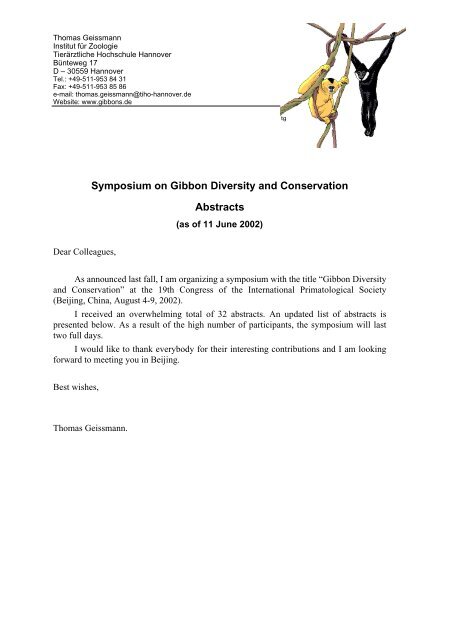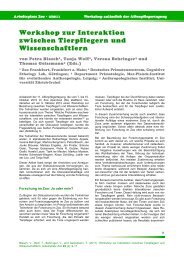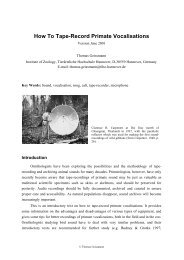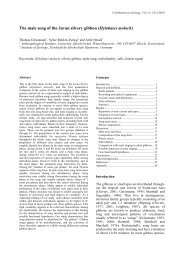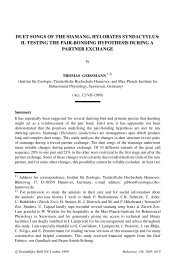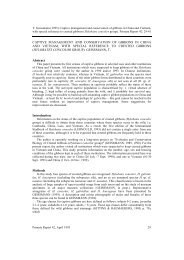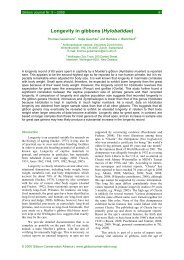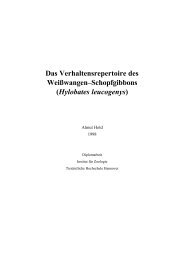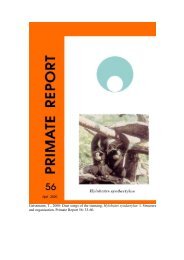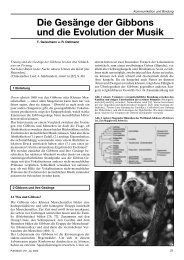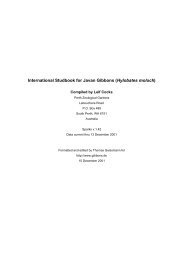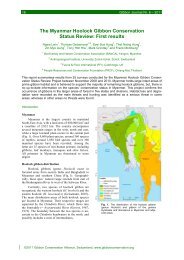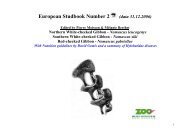here - Gibbon Research Lab
here - Gibbon Research Lab
here - Gibbon Research Lab
- No tags were found...
You also want an ePaper? Increase the reach of your titles
YUMPU automatically turns print PDFs into web optimized ePapers that Google loves.
Thomas GeissmannInstitut für ZoologieTierärztliche Hochschule HannoverBünteweg 17D – 30559 HannoverTel.: +49-511-953 84 31Fax: +49-511-953 85 86e-mail: thomas.geissmann@tiho-hannover.deWebsite: www.gibbons.detgSymposium on <strong>Gibbon</strong> Diversity and ConservationAbstracts(as of 11 June 2002)Dear Colleagues,As announced last fall, I am organizing a symposium with the title “<strong>Gibbon</strong> Diversityand Conservation” at the 19th Congress of the International Primatological Society(Beijing, China, August 4-9, 2002).I received an overwhelming total of 32 abstracts. An updated list of abstracts ispresented below. As a result of the high number of participants, the symposium will lasttwo full days.I would like to thank everybody for their interesting contributions and I am lookingforward to meeting you in Beijing.Best wishes,Thomas Geissmann.
Symposium “<strong>Gibbon</strong> Diversity and Conservation”, Beijing, August 2002: AbstractsiiContents:Territoriality and monogamy in hoolock gibbons 1M. Farid Ahsan........................................................................................................ 1Hoolock gibbons in Bangladesh: Status and conservation issues 2M. Farid Ahsan........................................................................................................ 2Social behavior and social organization (and social traditions?) in white-handedgibbons 3Thad Q. Bartlett ....................................................................................................... 3Behavioral diversity within Hylobatidae 4Warren Y. Brockelman and Udomlux Suwanvecho ............................................... 4Kalaweit <strong>Gibbon</strong>s Conservation Project in Kalimantan, Indonesia 5Aurelien Brule (Chanee) ......................................................................................... 5Feeding habits of hoolock gibbons in the <strong>Gibbon</strong> Wildlife Sanctuary, Assam(India) 6Pranab Bujarbarua and S.K. Sarma ......................................................................... 6Biogeography of gibbons: Congruence testing with other South-east Asianprimates 7Helen J. Chatterjee .................................................................................................. 7Assessing the viability of rehabilitation and reintroduction of ex-captive gibbons(Hylobates agilis albibarbis and Hylobates muelleri ssp.) in IndonesianBorneo 8Susan M. Cheyne..................................................................................................... 8Paternal care in a family of white-handed gibbons (Hylobates lar) 9Zsófia Clemens, Mária Ujhelyi and Björn Merker.................................................. 9Distribution and conservation of hoolock gibbons in Assam (India) 10Jayanta Das, P.C. Bhattacherjee and S.M. Mohnot............................................... 10Effect of habitat destruction on behaviour and ecology of hoolock gibbons 11Jayanta Das and P.C. Bhattacherjee ...................................................................... 11Hoolock gibbons (Bunopithecus hoolock) of Bangladesh: Status, distribution andconservation 12Mohammed M. Feeroz .......................................................................................... 12<strong>Gibbon</strong>s: In the shadow of the great apes 13Thomas Geissmann ............................................................................................... 13The Javan silvery gibbon (Hylobates moloch): Are t<strong>here</strong> several subspecies? 14Thomas Geissmann, Robert Dallmann and Jennifer Pastorini.............................. 14W<strong>here</strong> nomenclature is a stumbling block: The Bunopithecus problem 15Colin Groves.......................................................................................................... 15Status of hoolock gibbons in India: Conservation issues and concerns 16Atul K. Gupta ........................................................................................................ 16Distribution and conservation of the western black crested gibbon (Nomascusconcolor) in Wuliang mountain, Yunnan province, China 17Jiang Xuelong and Wang Yingxiang..................................................................... 17
Symposium “<strong>Gibbon</strong> Diversity and Conservation”, Beijing, August 2002: AbstractsiiiCommunity consensus on protecting Vietnam’s last black gibbons 18Mai Dang Khoa, James Hardcastle and Frank Momberg ..................................... 18Intergroup interactions and the role of calling among siamangs 19Margaret Kinnaird, Timothy O’Brien, Anton Nurcahyo and MayaPrasetyaningrum .................................................................................................... 19Survival rates in captive lar gibbons (Hylobates lar) and siamangs(Symphalangus syndactylus) 20Christina Klein and Lori K. Sheeran ..................................................................... 20Multi-male siamang groups: Polyandry and cooperation in a Sumatran gibbon 21Susan Lappan ........................................................................................................ 21Social communication by the use of gestures and facial expressions withinfamilies of siamangs (Symphalangus syndactylus) in zoological gardens 22Katja Liebal and Michael Tomasello .................................................................... 22Long-term field data, emerging perspectives, and human influences: Theimportance of integration in hylobatid conservation 23Nicholas Malone and Agustin Fuentes.................................................................. 23The importance of stress reduction when housing gibbons in a captive setting 24Alan R. Mootnick .................................................................................................. 24Effect of forest fire disturbance on the demography of siamang (Symphalangussyndactylus) in a Sumatran rainforest 25Timothy O’Brien, Margaret Kinnaird, Maya Prasetyaningrum, AntonNurcahyo and Muhammad Iqbal ........................................................................... 25The gibbons in Vietnam: Distribution and conservation status 26Pham Nhat ............................................................................................................. 26Preliminary observations on wild yellow-cheeked crested gibbons (Nomascusgabriellae) in eastern Cambodia 27Benjamin Rawson.................................................................................................. 27Mirror self-recognition in gibbons (Hylobatidae) 28Tanya A. Romaniuk .............................................................................................. 28Status review of black crested gibbons (Nomascus concolor and Nomascus sp.cf. nasutus) in Vietnam 29La Quang Trung, Trinh Dinh Hoang, Barney Long and Thomas Geissmann ...... 29Cognitive differences among small apes based on their behaviour in the presenceof mirrors 30Maria Ujhelyi and Zsofia Clemens ....................................................................... 30The survey project for captive gibbons in Taiwan and South-east Asia 31Ci-Wen Yang, Hou-Chun Chen, Po-Chung Chang and Kuang-Yu Hu ................ 31The population distribution and abundance of siamangs (Symphalangussyndactylus) and agile gibbons (Hylobates agilis) in west central Sumatra 32Achmad Yanuar, David J. Chivers and Jito Sugardjito......................................... 32
Abstracts, Symposium “<strong>Gibbon</strong> Diversity and Conservation”, Beijing, August 2002 1Territoriality and monogamy in hoolock gibbonsM. Farid AhsanPresent address: EPSS/MESU, Environment Department, PO Box 67, Dubai, UAE, e-mail:mfaridahsan@yahoo.comPermanent address: Department of Zoology, University of Chittagong, Chittagong 4331, Bangladesh, e-mail:mfahsan@ctgu.eduKey Words: Bunopithecus hoolock, social behavior, BangladeshI collected data on territoriality and social structure of the hoolock gibbons (Bunopithecushoolock). The gibbons were studied in the Lawachara area of the West Bhanugach ReserveForest, Sylhet (Bangladesh). Data were collected between July 1989 and July 1990.Hoolock gibbons defend territories with fixed boundaries against neighbouring groups.Territorial disputes occur mainly over occupancy of food sources. The hoolock gibbon ismonogamous. Monogamy appears to be maintained by adult mated females throughexclusion of potentially reproductive other females, w<strong>here</strong>as adult males areopportunistically polygynous.
Abstracts, Symposium “<strong>Gibbon</strong> Diversity and Conservation”, Beijing, August 2002 2Hoolock gibbons in Bangladesh: Status and conservation issuesM. Farid AhsanPresent address: EPSS/MESU, Environment Department, PO Box 67, Dubai, UAE, e-mail:mfaridahsan@yahoo.comPermanent address: Department of Zoology, University of Chittagong, Chittagong 4331, Bangladesh, e-mail:mfahsan@ctgu.eduKey Words: Bunopithecus hoolock, status, BangladeshThe status and conservation issues of the hoolock gibbons of Bangladesh are discussed,based on primate field studies carried out since 1979. Different forested areas of thecountry were frequently surveyed from a conservational point of view. Habitat loss wasidentified as the main reason for dwindling gibbon population in Bangladesh. The majorfactors of habitat loss are discussed and several suggestions on how to conserve thegibbons and the biodiversity in the survey areas are presented.
Abstracts, Symposium “<strong>Gibbon</strong> Diversity and Conservation”, Beijing, August 2002 3Social behavior and social organization (and social traditions?)in white-handed gibbonsThad Q. BartlettDepartment of Anthropology, The University of Texas at San Antonio, 6900 North Loop 1604 West, SanAntonio, TX 78249, U.S.A., e-mail: tbartlett@utsa.eduKey Words: Hylobates, social behavior, territoriality<strong>Gibbon</strong>s are broadly recognized as territorial in the classic sense of maintaining areas ofexclusive use. As a result, it is commonly assumed that gibbon groups represent socialisolates and that intra-group social interaction is rare and inter-group interactions areexclusively hostile. However, observations of white-handed gibbons in Khao Yai NationalPark, Thailand have demonstrated that inter-group encounters are not exclusively hostileand that the level of intra-group social activity is higher than previously estimated. Thesefindings obligate a reconsideration of territoriality and social organization among gibbons.From January 1994 to January 1995 the socio-ecology of two previously habituatedgibbon social groups was studied as part of continuing research on white-handed gibbons(Hylobates lar) in Khao Yai National Park, Thailand. During full-day follows I recordedthe occurrence of both intra- and inter-group social interactions. Affiliative social behaviorwas classified as wrestle play, chase play, grooming, and social contact. The overall rate ofsocial behavior was 11% and varied considerably between months (range 3-20%). Rates ofsocial activity were highest during the hot dry season when ripe fruit was most abundant.Grooming was the most common social activity in all age-sex classes except juveniles. Allcategories of social behavior were also recorded between individuals from neighboringgroups. Young gibbons, in particular, regularly turned to other groups to find socialpartners.I argue that affiliative social interactions between neighbors are indicative of acomplex social system that can be described by a nested hierarchy. I hypothesize that ateach level of this hierarchy the boundaries between groups are linked to aspects of thephysical landscape and may be maintained through social traditions<strong>Research</strong> supported by grants from Fulbright, The National Science Foundation,Boise Fund, Sigma Xi, The American Society of Primatologists and Dickinson College.
Abstracts, Symposium “<strong>Gibbon</strong> Diversity and Conservation”, Beijing, August 2002 4Behavioral diversity within HylobatidaeWarren Y. Brockelman 1,2 and Udomlux Suwanvecho 21Center for Conservation Biology, ISTRD, Mahidol University, Salaya, Phutthamonthon, Nakhon Pathom73170, Thailand, e-mail: wybrock@cscoms.com2Department of Biology, Faculty of Science, Mahidol University, Rama VI Road, Bangkok 10400, ThailandKey Words: adaptive radiation, Hylobatidae, territorialityThe gibbons comprise a family of 11 species of apes which started speciating at least 5million years ago. This is ample time in which to have evolved behavioral and ecologicaldifferences among the species, yet all extant species appear to be characterized by smallterritorial groups, long term monogamous pairing, and loud songs which in most speciesare structured duets. This talk addresses three questions: (1) what behavioral variabilityexists among the species, (2) what is the range of variability within species, and (3) whathas constrained the evolution of behavioral and ecological diversity within the family.Detailed observations of behavior and ecology exist for nearly all species, but long termobservations of group formation and dynamics exist for only two: Hylobates(Symphalangus) syndactylus and Hylobates lar. The long term studies indicate that groupcomposition and pair formation methods are more flexible than previously thought, butthat long term monogamous pairing is the predominant, if not the sole, social pattern.<strong>Gibbon</strong> species differ in details of vocal behavior, song pattern, diet, and perhapsgroup size, but a lack of knowledge of the range of variation within most species precludesan assessment of the significance of species differences. It is <strong>here</strong> argued that the relativelack of behavioral diversity within the family Hylobatidae is due to ecological andassociated morphological constraints. Explaining how these constraints operate will requireanswers to the following questions: (1) why does the ‘gibbon niche’ require small groupsize and territorial behavior; (2) how have the gibbons’ food resource requirements andterritorial behavior prevented sympatry between the species (excepting the siamang), andhence largely restricted adaptive radiation within the family. More detailed and integratedstudies of ranging, diet, foraging, and social behavior, especially competition, are neededto answer these questions.
Abstracts, Symposium “<strong>Gibbon</strong> Diversity and Conservation”, Beijing, August 2002 5Kalaweit <strong>Gibbon</strong>s Conservation Project in Kalimantan, IndonesiaAurelien Brule (Chanee)Etho-Passion Society, Jl Pinus No 14, Palangka Raya, Central Kalimantan, Indonesia, e-mail:kalaweit@hotmail.comKey Words: gibbons, rehabilitation, IndonesiaThe Island of Borneo harbours an enormous variety of animal and plant species. Amongthe life forms found <strong>here</strong> are many primates of which two are anthropoids. The first andbest known is the orang-utan (Pongo pygmaeus). The second, also threatened, is thegibbon. Two gibbon species occur on Borneo: the agile gibbon (Hylobates agilis) and theMueller’s gibbon (Hylobates muelleri). Etho-Passion (EP), a French society ofconservation, have created the first Kalimantan gibbon conservation program: the KalaweitProgram. This program was started on 29 September 1999 with the signature of theMemorandum of Understanding between EP and the Ministry of Forestry and Estate Cropsof the Republic of Indonesia. The program receives infant animals whose mothers havebeen killed, with the aim of avoiding the same fate for them. The rehabilitation center(Kalaweit Station) is situated in the virgin jungle of the Bukit Baka Bukit Raya NationalPark (181,090 ha). The gibbons’ return to the wild will be a process covering several years.The Kalaweit Program shall include rehabilitation, research, socialization/information (incollaboration with several radio / TV stations), education, and technical assistance for tohelp the local government in the protection of the Bukit Baka Bukit Raya National Park.
Abstracts, Symposium “<strong>Gibbon</strong> Diversity and Conservation”, Beijing, August 2002 6Feeding habits of hoolock gibbons in the<strong>Gibbon</strong> Wildlife Sanctuary, Assam (India)Pranab Bujarbarua 1 and S.K. Sarma 21Plant Ecology <strong>Lab</strong>., Department of Botany, Gauhati University, Guwahati; P.O. Gauhati University; 781014 Assam (India), e-mail: pranab_bujarbarua@rediffmail.com2Plant Ecology <strong>Lab</strong>., Department ob Botany, Gauhati University, Guwahati; P.O. Gauhati University; 781014 Assam (India).Key Words: food habits, hoolock gibbon, gibbon wildlife sanctuaryWe carried out a study on the feeding habits of the primates of <strong>Gibbon</strong> Wildlife Sanctuaryin Assam (India) during 1998-1999. The sanctuary harbours 7 species of non-humanprimates within an area of 1915.6 hectares. A total of 288 hours observation on thehoolock gibbons (Bunopithecus hoolock) of the sanctuary revealed that they spend 25.17%and 33.79% of their daily activity feeding during the wet and the dry season, respectively.Fruits formed 72.97% of the gibbon diet during the wet season, w<strong>here</strong>as the gibbons atemostly leaves (young and mature) during the dry season. Besides, the gibbons also ateminor amounts of flower buds, flowers, leaf petioles, moss, algae, lichen and insects. Atotal number of 21 plant species belonging to 13 families and 18 genera were used as foodby the gibbons of the sanctuary. Intra- and interspecific interactions were also observedduring our study. Interspecific interactions involving gibbons and capped langurs wereobserved at food sources used by both primate species. Our study documents that leavesform a major part of the diet of hoolock gibbons of the sanctuary during the dry season,although most gibbons are usually considered to be frugivorous animals.
Abstracts, Symposium “<strong>Gibbon</strong> Diversity and Conservation”, Beijing, August 2002 7Biogeography of gibbons: Congruence testingwith other South-east Asian primatesHelen J. ChatterjeeGrant Museum of Zoology, Department of Biology, Darwin Building, University College London, GowerStreet, London, WC1E 6BT, U.K., e-mail: h.chatterjee@ucl.ac.ukKey Words: biogeography, component analysis, congruence testingPhylogenetic and biogeographic relationships among gibbons are investigated, andcompared with macaques. Congruence between the two analyses is tested to reconstruct amodel of the pattern of radiation of gibbons in South East Asia.Multiple gene data for eleven gibbon species representing the four gibbon genera(Nomascus, Symphalangus, Bunopithecus and Hylobates) are used to reconstructphylogenetic interrelationships. Published data, derived from the European BioinformaticInstitute’s EMBL database, are analysed using maximum likelihood, parsimony andbootstrapping methods. The following genes are employed: cytochrome b, 12S and 16SRNA and D4. For comparison, multiple gene data (cytochrome b, NADH, SRY,NRAMP1, and TSPY) for sixteen species of macaque are analysed using the samemethods. For each phylogenetic analysis the multiple gene data are combined to derive twoconsensus phylogenetic trees; one for gibbons, and one for macaques. A molecular clock isemployed to provide an estimate of the date of the gibbon and macaque radiations.The consensus phylogenetic trees for gibbons and macaques are used inbiogeographic analyses to reconstruct the pattern of radiation leading to the present daydistributions. Taxon area cladograms are created using distribution data in association withthe consensus trees derived from the molecular analyses. Four methods of biogeographicreconstruction are employed: ancestral area analysis using irreversible parsimony, ancestralarea analysis using reversible parsimony, dispersal-vicariance analysis (DIVA) andcomponent analysis. AA and DIVA analyses are used to reconstruct patterns of radiationfor gibbons and macaques. Results of the analyses are compared. Component analysis isimplemented to test the congruence between the gibbon and macaque taxon areacladograms. Results of the biogeographic analyses are compared and combined with theestimates of the timing of radiations to reconstruct a model of the pattern of radiation ofgibbons and macaques. The various forms of cladistic biogeography are also appraised.
Abstracts, Symposium “<strong>Gibbon</strong> Diversity and Conservation”, Beijing, August 2002 8Assessing the viability of rehabilitation and reintroduction of ex-captivegibbons (Hylobates agilis albibarbis and Hylobates muelleri ssp.) inIndonesian BorneoSusan M. CheyneWildlife <strong>Research</strong> Group, Department of Anatomy, University of Cambridge, Downing Street, CambridgeCB2 3DY, U.K., e-mail: fael_inis@hotmail.comField address: Kalaweit Care Centre, Jl. Pinus No. 14, Palangka Raya, Kalteng, Indonesia.Key Words: gibbons, rehabilitation, IndonesiaThe past 30 years have seen vast resources/research time focusing onrehabilitation/reintroduction of orang-utans throughout their home range. Until now, allsimilar efforts to rehabilitate ex-captive gibbons have been educated guesswork,accompanied up by little or no pre-release assessment of the suitability of the individualsinvolved, or follow-up monitoring. The only report on a gibbon rehabilitation project inThailand states that all releases failed, probably due to the poor quality relationshipsbetween the released adults. Most releases from this project have been based on subjectiveimpression and not objective scientific data. Until this issue is addressed, many releasedgibbons will continue to perish, having contributed nothing to the survival potential of thespecies.A study was initiated in March 2002 to begin systematic behavioural assessment ofex-captive gibbons being rehabilitated at the Kalaweit Programme, Central Kalimantan.Upon arrival at Kalaweit, all gibbons are placed in quarantine cages to undergo medicaltesting: for TB (anti TB Igg), HepBsAb, HepBsAg, anit-HSV1 and anti-HSV2 antibodies.<strong>Gibbon</strong>s are housed alone until results are known. Healthy gibbons are transported to t<strong>here</strong>habilitation site located in the Bukit Baka/Bukit Raya National Park. Only maturesubadults and adults are considered for release.Initial findings on feeding and social behaviour, and activity patterns of the excaptivesare presented, with comparisons to wild populations. The validity of the results astools for identifying if (a) an individual is suitable for rehabilitation and (b) a pair issuitable for release, are appraised. Also presented are future research plans and how thepreliminary data is being used to plan future releases and pair compatible individuals atKalaweit.I suggest that several factors in the individual’s life history may be involved in thedifferences between the gibbons’ performances in the rehabilitation process.
Abstracts, Symposium “<strong>Gibbon</strong> Diversity and Conservation”, Beijing, August 2002 9Paternal care in a family of white-handed gibbons (Hylobates lar)Zsófia Clemens 1 , Mária Ujhelyi 2 and Björn Merker 31Institute of Behavioural Sciences, Semmelweis University, Budapest, Hungary, e-mail:clemenszsofia@hotmail.com2Institute of Behavioural Sciences, Semmelweis University, Budapest, Hungary, e-mail:bjorn.merker@kmh.se3Center for <strong>Research</strong> in Music Education, The Royal University College of Music, Stockholm, Sweden, e-mail: ujhmar@net.sote.huKey Words: Hylobates lar, paternal care, parental investmentAmong the small apes, only siamang males are known to display extensive paternalcaretaking behaviour. Here we report on paternal behaviour observed in a white-handedgibbon (Hylobates lar) family at the Debrecen Zoo (Hungary). The animals were observedand filmed for 4 hours, every 6 weeks, throughout one year. Behavioural measures takenfrom the films for the analysis were as follows: types and duration of social parentoffspringinteractions; and the initiator of all dyadic social interactions. In order to getfurther information about parental motivations, two types of interventions were introduced:1. preferential feeding to check patterns of food sharing; 2. alternating separation of thegroup members.During the study period we observed sustained biparental care. The male was highlyinterested in the infant and spent a substantial amount of time in dyadic interactions with it.Although the male’s interactions with the infant included most elements of maternal care,the pattern of dealing with the infant (type of care, time budget, and initiating interactions)showed marked gender differences and changes in time span. While the comfort-givingbehaviours (carrying, defending) were largely carried out by the female, behavioursrequiring more tolerance (such as playing and food sharing) were displayed by the father.Because some field observations and our unpublished study on siamangs also supportthe presence of similar preferential maternal and paternal roles, we suggest that a tendencytoward role differentiation is present in small apes which deserves further research.
Abstracts, Symposium “<strong>Gibbon</strong> Diversity and Conservation”, Beijing, August 2002 10Distribution and conservation of hoolock gibbons in Assam (India)Jayanta Das 1,2 , P.C. Bhattacherjee 1 and S.M. Mohnot 21Animal Ecology and Wildlife Biology <strong>Lab</strong>., Department of Zoology, Gauhati University, Guwahati-781014, Assam, India, e-mail: gibbonconservation@yahoo.com2Primate <strong>Research</strong> Centre, 396, 3rd ‘C’ Road, Sardarpura, Jodhpur 342003, India, e-mail:prcindia@sify.comKey Words: Bunopithecus hoolock, status, IndiaThe distribution in relation to time and space is the core to the evaluation of the speciesstatus. But a wider distribution range does not necessarily qualify better success andsurvival possibilities. Detailed surveys were carried out in 110 forests in 16 forest divisionsof Assam during 1995-1997. The state Assam with a geographic area of 78,438 km 2 has 5National Parks, 14 Wildlife Sanctuaries and several Reserve Forests (17,422 km 2 ),Proposed Reserve Forests (2,815 km 2 ), Unclassed State Forests (5,894 km 2 ). Protectedareas in Assam cover only 2.63% of the total geographic area of the state, and hoolockgibbons (Bunopithecus hoolock) are found in only 1.03% of the protected areas. An area of6,405 km 2 has been estimated as hoolock habitat. Hoolock gibbons were recorded from 5Protected Areas and from 62 other forests of all surveyed forests. Most protected areas areeither grasslands or too small to support a viable population. The major threat for hoolockgibbons in Assam is habitat loss, followed by hunting and improper implementation ofWildlife Protection Acts and Laws. Thirty candidate priority areas and 6 conservationlandscapes have been identified for future hoolock gibbon conservation in Assam.This survey was supported by the grant agreement no. INT / FWS-22.
Abstracts, Symposium “<strong>Gibbon</strong> Diversity and Conservation”, Beijing, August 2002 11Effect of habitat destructionon behaviour and ecology of hoolock gibbonsJayanta Das 1,2 and P.C. Bhattacherjee 11Animal Ecology and Wildlife Biology <strong>Lab</strong>., Department of Zoology, Gauhati University, Guwahati-781014, Assam, India, e-mail: gibbonconservation@yahoo.com2Primate <strong>Research</strong> Centre, 396, 3rd ‘C’ Road, Sardarpura, Jodhpur 342003, India, e-mail:prcindia@sify.comKey Words: Bunopithecus hoolock, ecology, IndiaThe survival of frugivorous, brachiator species like gibbons mostly depends on thecontinuous availability of sufficiently rich food sources throughout the year. During anextensive field study from October 1998 to December 2000, two groups of hoolockgibbons (Bunopithecus hoolock) were observed, one in undisturbed (Namdapha NationalPark) and one disturbed habitat (Borajan Reserved Forest). A major difference in theactivity patterns was observed between the two habitats: In the disturbed habitat, gibbonsspent less time feeding (42.78% versus 54.28%), grooming (0.94% versus 2.32%, andsinging (0.63% versus 1.60%); w<strong>here</strong>as they spent more time resting (46.17% versus33.64%), travelling (6.17% versus 5.59%) and monitoring (2.96% versus 2.14%). Thedistribution and abundance of the food resources in different seasons is thought torepresent the major guiding factor for allocating time in various activities in differenthabitats. These differences in the major activities have serious long-term consequences forthe survival of hoolock gibbons.This study was supported by the grant agreement no. INT / FWS-22.
Abstracts, Symposium “<strong>Gibbon</strong> Diversity and Conservation”, Beijing, August 2002 12Hoolock gibbons (Bunopithecus hoolock) of Bangladesh:Status, distribution and conservationMohammed M. FeerozDepartment of Zoology, Jahangirnagar University, Savar, Dhaka-1342, Bangladesh, e-mail:feeroz@juniv.eduKey Words: Bunopithecus hoolock, conservation, BangladeshAmong the nine species of primates of Bangladesh, hoolock gibbon Bunopithecus hoolockis the only lesser apes found in the evergreen and semi-evergreen forests of north-east andsouth-east of the country. Group size of B. hoolock varied from 2 to 5 (mean = 3.03,sd±0.82, n = 34), population density varying from 0.5 to 1.3 gibbons/km 2 (mean = 0.8gibbons/km 2 ). This species is found in monogamous families comprising of one adult maleand one adult female with their offspring. This species is sympatric with three otherprimate species in most of its habitat. The population of this species is declining in allother areas except the West Bhanugach Forest Reserve. This forest reserve supports nearly30% hoolock gibbon groups of the country. Rapid degradation of the forest due toincreased population pressure, highway construction, expansion of agricultural field, betelcultivation, unlimited fuel wood extraction and cattle grazing are the major constant threatsfor the survival of this species in Bangladesh. T<strong>here</strong> is no existing laws for the protectionof this species or no area has been declared as gibbon sanctuary in the country.
Abstracts, Symposium “<strong>Gibbon</strong> Diversity and Conservation”, Beijing, August 2002 13<strong>Gibbon</strong>s: In the shadow of the great apesThomas GeissmannInstitute of Zoology, Tierärztliche Hochschule, Bünteweg 17, 30559 Hannover, Germany, e-mail:thomas.geissmann@gibbons.deKey Words: species loss, vanishing apes, conservation biasIn an ever increasing way, media and scientists alike have succeeded in making us awareof the plight of the great apes, while at the same time ignoring the gibbons or small apes.We are being taught that the great apes are “neglected apes”, “forgotten apes” or“vanishing apes” (book titles on great apes), and that our first conservation priority amongprimates should be directed at these species. A simple review of research and publicationactivities documents that not the great apes, but the small apes are the true neglected orforgotten apes. Similarly, a review of the population numbers suffices to show thatconservation priorities should be directed at small apes. Even the most endangered speciesof great apes (Pongo abelii) still has populations of more than 10,000 individuals in thewild. In contrast, t<strong>here</strong> are at least three gibbon species (e.g. Nomascus concolor, N. sp. cf.nasutus, Hylobates moloch) with less than 3,000 individuals. Population sizes of severalgibbon species have not been estimated since the early 1980’s or are “data deficient.”W<strong>here</strong>as research on, and conservation activities directed at, the great apes are supportedby a strong lobby, gibbons tend to be overlooked whenever media, scientists, fundingagencies and conservation agencies are referring to apes. <strong>Gibbon</strong>s are largely ignored incurrent debates about ape conservation (bush meat, world heritage status for great apes,etc.). The long-standing tradition to favor great apes, or to ignore the small apes, has inrecent years contributed to divert from the increasingly critical status of many gibbonpopulations and may result in the loss of several ape species. In order to survive, the smallapes need to get out of the shadow of the great apes and obtain an equivalent share ofattention from conservation agencies, scientists and media alike.
Abstracts, Symposium “<strong>Gibbon</strong> Diversity and Conservation”, Beijing, August 2002 15W<strong>here</strong> nomenclature is a stumbling block: The Bunopithecus problemColin GrovesSchool of Archaeology & Anthropology, Australian National University, Canberra, ACT 0200, Australia, e-mail: colin.groves@anu.edu.auKey Words: hylobatidae, hoolock gibbon, BunopithecusThe 14 or so species of gibbons (Hylobatidae) have, until recently, been placed in a singlegenus, Hylobates, with four subgenera. The hoolock gibbon is called Hylobates(Bunopithecus) hoolock under this scheme. It has been argued by Geissmann and othersthat the four subgenera would be better ranked as full genera, and this seems appropriatefor many reasons – in particular, the genetic distances between them, at least as far asmtDNA is concerned, are greater than that between Homo and Pan. But generic nameshave a high profile in a way which subgeneric names do not, and if we are to raise thesubgenera to genera we must examine whether the names are appropriate.The name Bunopithecus is based on a fossil jaw fragment, with two molars, from theMiddle Pleistocene site of Yanjinggou (Yenchingkou), in Sichuan, China. The name hasbeen used for the hoolock because the molars are said to show the features by which thoseof the hoolock differ from other gibbons. Close examination shows that the fossil actuallystands outside the range of morphology of modern gibbons; probably the genusBunopithecus is valid, but refers only to the fossil species, B. sericus. A new generic namemust be coined for the hoolock.
Abstracts, Symposium “<strong>Gibbon</strong> Diversity and Conservation”, Beijing, August 2002 16Status of hoolock gibbons in India: Conservation issues and concernsAtul K. GuptaDepartment of Population Management, Capture & Rehabilitation, Wildlife Institute of India, PO Box 18,Chandrabani, Dehradun 248 006, Uttaranchal, India, e-mail: akg@wii.gov.inKey Words: Bunopithecus hoolock, status, IndiaThe hoolock gibbon (Bunopithecus hoolock), the only ape species in India, is the westernmost of the nine species of lesser apes of Southeast Asia. Its distribution is restricted to themonsoon and evergreen rain forests of northeast India south of Brahmaputra River,Southern Yunnan and Myanmar up to the river Chindwin. Although, it is categorized asendangered by IUCN and listed in Schedule I of the Wildlife (Protection) Act, 1972 ofIndia. Present knowledge of gibbon ecology and population estimate comes only from fewstudies. Lowland tropical rain forests in northeast India, the major gibbon habitats, are themost species-rich of the terrestrial ecosystems. These lowland forests, however, are nowpresent in form of fragments of varying size, shape, and succession stages mainly due toagricultural expansion, illegal encroachment, shifting cultivation, establishment of tea andcoffee estates, illegal logging, poaching and hunting, and diversion of forest land fordevelopmental projects as faulty land-use policies.The gibbons’ frugivorous diet, high territoriality, and adaptation for brachiationeasily make them the most threatened species in those areas w<strong>here</strong> habitat loss andfragmentation have been intense. Fragmentation of the habitat may result in reducedavailability of their preferred food-fruit and their highly territorial nature or ‘spatialinflexibility’ may prevent them from exploiting food resources in adjoining areas. Further,their brachiatory locomotion makes their movement impossible in habitats without canopycontiguity. The population size of monogamous gibbons having small family size and lowreproductive output can not exceed beyond a small maximum even if environmentalconditions improve. The ideal conservation measures may include both short-and longtermmeasures including check on fragmentation, poaching and illegal hunting for ethnicmedicines, and conservation education to create awareness on the conservation of gibbons.
Abstracts, Symposium “<strong>Gibbon</strong> Diversity and Conservation”, Beijing, August 2002 17Distribution and conservation of the western black crested gibbon(Nomascus concolor) in Wuliang mountain, Yunnan province, ChinaJiang Xuelong and Wang YingxiangKunming Institute of Zoology, Chinese Academy of Science, Kunming 650223, China, e-mail:jiangxl@mail.kiz.ac.cnKey Words: Nomascus concolor, status, ChinaWuliang mountain was declared a provincial reserve in 1986 and was upgraded to anational reserve in 2000. It is located in central Yunnan, China, between the Mekong andBlack rivers, and includes parts of three counties (Jingdong, Zhengyuan, and Nanjian).Ecology, behaviour and conservation of the western black crested gibbon (Nomascusconcolor) have been studied t<strong>here</strong> since 1985. The gibbon of Wuliang mountain wasdescribed as a distinct subspecies (N. c. jingdongensis) in 1986. Previous estimates of itspopulation size differed widely (51-300 groups).We present new results of a detailed survey of this population and its distribution,conducted by five teams from November 4, 2001, to January 6, 2002. Two teams surveyedthe eastern slope and two teams the western slope in Jingdong and Zhengyuan, and oneteam surveyed the Nanjian sector. Groups were identified and located by theircharacteristic loud calls and direct sightings. We recorded ninety-seven gibbon groups inWuliang. They inhabit semi-humid evergreen broad-leaved forest and mid-montane humidevergreen broad-leaved forest at elevations of 1800-2660 meters. <strong>Gibbon</strong>s are moreabundant in the southern part, with more groups occurring on the eastern than on thewestern slope. Previous reports suggested that the population was isolated in 38 forestpatches ranging from 70-2500 ha in 1995.Our current surveys show that habitat fragmentation is less severe than reportedbefore. The population is thinly spread, however, because some neighbouring groups areseparated by distances of 3-4 kilometers. The low population density is now the mainconcern for the conservation of this endemic subspecies. Our study also demonstrates thathunting and deforestation are still resulting in the extirpation of groups and habitat loss insome areas. In addition, road and power-line constructions are increasing the fragmentationof the population.
Abstracts, Symposium “<strong>Gibbon</strong> Diversity and Conservation”, Beijing, August 2002 18Community consensus on protecting Vietnam’s last black gibbonsMai Dang Khoa, James Hardcastle and Frank MombergFauna & Flora International – Indochina Programme, IPO Box 78, 104B Pho Hue, Hanoi, Vietnam, e-mail:ffi@fpt.vnKey Words: Nomascus, conservation strategy, VietnamPrimate conservation initiatives in Vietnam largely fail to address a lack of lawenforcement, a lack of conservation awareness, and a lack of land-use planning that takesinto account the need for biodiversity conservation. Top-down approaches in protectedarea gazettement have alienated local communities.Fauna & Flora International’s (FFI) discovery of 39 groups of western black crestedgibbons (Nomascus concolor) in Che Tao forest, North Vietnam, reconfirmed theircontinued existence in the country for the first time since the 1960’s. To date a minimumof 91 individuals are confirmed in Che Tao – without doubt the largest population of thespecies in Vietnam, yet critically threatened by habitat fragmentation and huntingpressures.In response, FFI initiated a strategy and action plan for the community and districtauthorities to take on protection activities themselves. This ‘evolved’ into a communitybasedproject. Under the banner of long-term protection for gibbons in Che Tao, the projecthas instilled a clear-cut sense of ownership amongst both local people and districtdepartments, to harness local capacity for conservation, and to demote FFI’s role tofacilitator.Key interventions include awareness raising, household-level gibbon hunting banagreements, community ‘forest stewardship councils’ to take on forest managementresponsibilities, and a land use mapping exercise to incorporate local resource needs intothe protection strategy.Building on the participatory approach and local consensus, the area will be gazettedas a ‘<strong>Gibbon</strong> Sanctuary’. This gazettement is based on three tenets: of community comanagement;of community access to resources; and local recruitment of forest rangers.Forest stewardship councils will be the foundation for the local management board of theSanctuary.FFI will continue to support Che Tao with an aim to build up local capacity tocontinue to develop a solid programme that supports conservation of gibbons, their habitatand local resource needs.
Abstracts, Symposium “<strong>Gibbon</strong> Diversity and Conservation”, Beijing, August 2002 19Intergroup interactions and the role of calling among siamangsMargaret Kinnaird, Timothy O’Brien, Anton Nurcahyo and Maya PrasetyaningrumWildlife Conservation Society, P. O. Box 311, Bogor, 16003, Indonesia, e-mail: wcs-ip@indo.net.idKey Words: siamang, territoriality, callingWe examine siamang calling in the context of territorial defense and describe intergroupinteractions among four habituated groups in a southern Sumatran rainforest. At least threegroups were followed simultaneously five days per month for one year. We recorded dayrange, feeding trees, frequency, location and direction of calls and counter calls, andcontext in which intergroup interactions occurred. Groups defended territories rangingfrom 14.8-26.7 hectares but territories overlapped by as much as 32%. Groups called andengaged in counter calling with neighbors more often from territory boundaries than fromthe center of territories. Groups directed calls and counter calls in an outward directionfour times more than toward territory centers. Number of fruiting trees in a siamangterritory had significant effects on frequency of monthly calling. Counter calling occurredmore often when inter-group distances were ≤50 m and in the proximity of fruiting trees.Counter calling was more strongly influenced by number of fruiting trees than callingalone, suggesting that neighbors call and counter call more often as territories becomemore valuable. Percent of fruit in the diet however had no significant effect on rates ofcalling or counter calling, suggesting that the defensibility of fruit resources is moreimportant than availability alone. The majority of intergroup interactions (inter-groupdistances ≤ 100 m) occurred in or in the proximity of fruiting trees and resulted in neutraloutcomes with both groups retreating from the conflict. The smallest group with thesmallest but richest territory was involved in the most intergroup interactions, and lostmost frequently when t<strong>here</strong> was a decisive outcome. Calling appears to be effective forterritorial defense but when calling fails to mediate conflict, group size may be important.Territorial defense remains the most parsimonious explanation for evolution of calling insiamangs.
Abstracts, Symposium “<strong>Gibbon</strong> Diversity and Conservation”, Beijing, August 2002 20Survival rates in captive lar gibbons (Hylobates lar)and siamangs (Symphalangus syndactylus)Christina Klein 1 and Lori K. Sheeran 21International Center for <strong>Gibbon</strong> Studies, POB 800249, Santa Clarita, CA 91830, U.S.A., e-mail:gibbon1@earthlink.net2Department of Anthropology, POB 6846, CSUF, Fullerton, CA 92834-6846, U.S.A., e-mail:lsheeran@fullerton.eduKey Words: survival rates, parental investment, gibbonsAspects of a species’ natural history, such as predation and diet, impact on life historytraits such as life span and maturation and mortality rates. We often lack data from wildpopulations to enable exploration of relationships between life history events and naturalhistory, but captive populations often provide a large database from which demographicinformation can be gleaned. Allman et al. (1998) 1 used studbook and other data to exploreprimate mortality in terms of the caregiving roles of adults. They hypothesized that the sexthat is the primary caregiver should have higher survival rates. They found that femalechimpanzees, spider monkeys, orangutans, lar gibbons, gorillas, and humans had a survivaladvantage over males. Male siamangs and Goeldi’s, owl, and titi monkeys had highersurvival rates than did their female counterparts, which they argued is a consequence ofthese males’ expanded caregiving roles. Using studbook data, we focused on lar gibbonsand siamangs to further explore Allman’s hypothesis and conclusions. For both species, wetested the null hypothesis that males and females have the same mortality rates. Becausemortality differences may become apparent or more pronounced at particular life stages,we ran logistic regressions on four reproductive age groups spanning 8 to 20+ years. Wealso compared the overall mortality rates of siamangs and lar gibbons. For both species, wefound that male and female mortality rates are the same. However, in all four reproductiveage groups, siamangs of both sexes have a survivorship advantage over lar gibbons of bothsexes. Our data do not support Allman’s hypothesis that sex differences in caregiving rolesyield differences in survival rates of the two sexes. Instead, we suggest that the siamang’ssurvival advantage is related to other aspects of its natural history, such as increasedfolivory.1Allman, J.; Rosin, A.; Kumar, R. & Hasenstaub, A. 1998: Parenting and survival in anthropoid primates:Caretakers live longer. Proceedings National Academy of Sciences 95(12): 6866-6888.
Abstracts, Symposium “<strong>Gibbon</strong> Diversity and Conservation”, Beijing, August 2002 21Multi-male siamang groups:Polyandry and cooperation in a Sumatran gibbonSusan LappanNew York Consortium for Evolutionary Primatology, Department of Anthropology, New York University,25 Waverly Place, New York, NY 10003, U.S.A., e-mail: sl232@nyu.eduKey Words: siamang, polyandry, mating systemMost early studies of hylobatid socioecology (e.g. Carpenter 1944; Chivers 1974)emphasized gibbon monogamy, characterized by long-term pair-bonds between adultmales and females, cooperative territorial defense, and the gradual peripheralization andemigration of offspring as they reached maturity. However, more recently, extra-paircopulation (Reichard & Sommers 1997; Palombit 1994), transfer of immatures betweengroups (Oka & Takenaka 2001), and even possible cases of social polygyny (Jiang et al.1999; Bleisch & Nan 1990) have been reported in gibbons. These observationsdemonstrate that gibbons display a much wider diversity of social and mating strategiesthan previously understood. At the WCS/ PHKA Way Canguk <strong>Research</strong> Station insouthern Sumatra, the long-term retention of multiple adult-sized males in siamang groupsis relatively common. This presentation reports new observations of polyandrous matingwithin three multi-male siamang groups, and discusses potential benefits of polyandry forsiamang males. A possible relationship between population density and siamang social andmating strategies is proposed.Siamangs are unusual among gibbons in that males have been reported to provideextensive care for infants, especially during the second year of infant life, in the form ofinfant carrying. In this study, infant carrying by all adult-sized males (and some immaturemales) in polyandrous groups was observed, although the frequency of infant carryingvaried between males, both within and between groups. While data on the relationshipbetween the number of males in a group and infant survival are not currently available,helping by “extra” males may provide an important benefit to dominant males. Toleranceof extra males within the group may also function to reduce the loss of paternity to extragroupmales.
Abstracts, Symposium “<strong>Gibbon</strong> Diversity and Conservation”, Beijing, August 2002 22Social communication by the use of gestures and facial expressions withinfamilies of siamangs (Symphalangus syndactylus) in zoological gardensKatja Liebal 1 and Michael Tomasello 21Max-Planck-Institute for Evolutionary Anthropology, Inselstraße 22, 04103 Leipzig, Germany, e-mail:liebal@eva.mpg.de2Max-Planck-Institute for Evolutionary Anthropology, Inselstraße 22, 04103 Leipzig, Germany, e-mail:tomas@eva.mpg.deKey Words: intentional signals, recipient’s state of attention, flexible use of signalsThe vast majority of work on primate communication has concerned vocalizations, but justas important are their gestures and facial expressions, which have been studied in only afew primate species, mostly in macaques and chimpanzees. Almost nothing is known aboutthe use of those signals in lesser apes (Hylobatidae) and the influence of social orecological factors on the communication of those primates.In the present study social communication using intentional signals was investigatedin captive siamang groups (Symphalangus syndactylus). The goal was 1) to describe thesignal repertoire (tactile, visual gestures, actions and facial expressions), 2) to focus ongender, sex and age differences and 3) to investigate the use of signals in terms offlexibility (context, attentional state of recipient).Fourteen individuals of four groups each consisting of an adult pair and two or threeoffspring were observed in two different zoos.During 138 hours of observation, 34 different signals containing 14 tactile and 10visual gestures, 6 actions as well as 4 facial expressions were observed. Tactile gesturesand facial expressions were observed most often. Differences between groups concerningthe number and frequency of used signals were caused above all by the social constellationof the family or housing conditions. Although most of the signals were common in allindividuals, some signals were only used by a particular age class. T<strong>here</strong> was also aninfluence of age in context with the use of the signals depending on the state of t<strong>here</strong>cipient. Adult siamangs performed visual signals exclusively toward an attendingrecipient, w<strong>here</strong>as infants used this signal category also toward a not attending individual.Differences between the repertoire of genders were less distinct.Summarizing the signal repertoire of siamangs can be described as variable andmultifaceted range of different signals, which underlies the influence of different social andecological parameters.
Abstracts, Symposium “<strong>Gibbon</strong> Diversity and Conservation”, Beijing, August 2002 23Long-term field data, emerging perspectives, and human influences:The importance of integration in hylobatid conservationNicholas Malone 1 and Agustin Fuentes 1,21Department of Anthropology, University of Oregon, Eugene, OR 97403-1218, U.S.A., e-mail:nmalone@darkwing.uoregon.edu2Department of Anthropology, Notre Dame University, Notre Dame, Indiana 46556-5639, U.S.A., e-mail:agustin.fuentes@cwu.eduKey Words: captive management, rehabilitation, gibbon conservationIntraspecific behavioral flexibility, as well as behavioral variability among closely relatedspecies, is becoming increasingly evident within the Order Primates. Additionally, manyprimate species are either considered endangered or critically endangered. Efforts toconserve and protect endangered nonhuman primates are influenced by the ways in whichwe view species diversity and behavioral variability, and also by how well conservationistsunderstand human cultural, economic, and social interconnections.Given certain complexities within the family Hylobatidae, including, but not limitedto, the occurrence of naturally occurring hybridization, effective conservation of theseorganisms must include consideration of both long-term field observations and humancultural and scientific influences. In light of an emerging perspective of hylobatid socialorganization based on recent data from long-term studies of free-living populations(Brockelman et al. 1998; Palombit 1995) and the re-examination of existing data sets(Fuentes 2000), approaches to the rehabilitation and captive management of hylobatidsshould be re-evaluated. Management strategies of displaced hylobatids should also bedeveloped in conjunction with the overall conservation goals for the species in question.For example, hylobatid breeding and public display may need to be in tight accordancewith integrated conservation priorities.We present a synthesis of data from monitoring efforts of the illegal pet-trade, abehavioral study of displaced hylobatids, and theoretical developments in hylobatid socialorganization. This effort emphasizes the complexities of hylobatid conservation in sourcecountries, as well as establishes a model for the assessment of human cultural impacts. Aprimary goal of this paper is to provide guidance for and stress the importance of futureexaminations of human and hylobatid interconnections in Southeast Asia.
Abstracts, Symposium “<strong>Gibbon</strong> Diversity and Conservation”, Beijing, August 2002 24The importance of stress reductionwhen housing gibbons in a captive settingAlan R. MootnickInternational Center for <strong>Gibbon</strong> Studies, P.O. Box 800249, Santa Clarita, CA 91380, U.S.A., e-mail:gibboncenter@earthlink.netKey Words: captive management, enclosure design, stress management<strong>Gibbon</strong>s (Hylobatidae) naturally live in the upper canopy, are generally observed in amonogamous family unit, and are known for their territorial defense. When housinggibbons in captivity, many factors need to be taken into consideration in order to reducetheir stress levels. It is not recommended to house more than one adult of the same sex inan enclosure. It is important to create visual barriers between enclosures to prevent hostiledisplays among gibbons. Hostile presenting between enclosures, or housing gibbons insmall enclosures could cause self-mutilation, abortion, infant neglect, displaced aggressionon infants, offspring to be peripheralized at an earlier age, or suppression of the immunesystem. It is important to gradually introduce gibbons to each other, especially if one of thegibbons is imprinted on humans. When housing immature gibbons without their parents,they should not be housed with a dominate or older gibbon who could hurt them. T<strong>here</strong>moval of an offspring from its family can stress the parents or other offspring. T<strong>here</strong> isthe potential for a gibbon to be an inadequate parent if it did not observe parental care ofsiblings. Humans should not be allowed to torment gibbons, and predators should beprevented from being in close proximity to gibbon enclosures. Having a barking dogencircle an enclosure has caused some gibbons to spend up to 3 weeks looking for the dogthroughout each day. Noise or machinery near gibbon enclosures could increase the chanceof aborting. The use of large machinery higher than a gibbon enclosure could causegibbons to abort. When removing gibbons from their enclosure, the best method for eachsituation should be taken into consideration in order to reduce their stress levels. If thesesuggestions are utilized when housing gibbons, they will live a much longer and healthierlife.
Abstracts, Symposium “<strong>Gibbon</strong> Diversity and Conservation”, Beijing, August 2002 25Effect of forest fire disturbance on the demography of siamang(Symphalangus syndactylus) in a Sumatran rainforestTimothy O’Brien, Margaret Kinnaird, Maya Prasetyaningrum, Anton Nurcahyo andMuhammad IqbalWildlife Conservation Society, P. O. Box 311, Bogor 16003, Indonesia, e-mail: wcs-ip@indo.net.idKey Words: siamang, demography, habitat disturbanceFew studies have attempted to quantify the effects of severe habitat disturbance on primatepopulation dynamics, and data on the demography of lesser apes is almost non-existent.We examined demographic characteristics of a siamang (Symphalangus syndactylus)population (n=38 groups, 130 group-years) from 1998 through 2001 in a southernSumatran forest recently disturbed by fires. The population was located in a national parkand not subject to hunting or logging disturbance.Groups adjacent to the burn area were smaller (3.2 vs. 4.0 individuals, P=0.039),produced fewer infants and juveniles (25.7% vs. 37.4%), and possessed smaller homeranges than groups in unburned forest habitat. Interbirth intervals were slightly longer forburn area groups (2.8 vs. 2.5 years), suggesting that females in the burned area may benutritionally stressed. Most important, infant and juvenile survival was significantly loweramong the burn area groups during the first four years of life. The probability of an infantsurviving to the subadult stage is 0.22 for burn area groups and 0.62 for groups in betterhabitat. Compared to groups in unburned forest, groups in burned forest had access to lessthan 50% as many large Ficus spp. and Dracontomelum dao trees, the two main fruits insiamang diets. We show that groups adjacent to burned forest occupy poor quality habitatwith fewer food sources, and we believe the reduced foraging time and increased restingtime associated with habitat disturbance results in the lower productivity and highermortality of young animals.
Abstracts, Symposium “<strong>Gibbon</strong> Diversity and Conservation”, Beijing, August 2002 26The gibbons in Vietnam: Distribution and conservation statusPham NhatFaculty of Forest Resources & Environment Management, Forestry University of Vietnam, Xuanmai, Hatay,Vietnam, e-mail: nhatfuv@hn.vnn.vnKey Words: Nomascus, status, VietnamAt least 5 subspecies of gibbons are found in Vietnam, including Nomascus concolorconcolor, Nomascus sp. cf. nasutus, Nomascus leucogenys leucogenys, Nomascusleucogenys siki, and Nomascus gabriellae. This paper provides information on their formerand present distribution and their conservation status. The most recent studies show thatthe distribution areas of all subspecies have been narrowing due to habitat loss. All taxa arethreatened to become extinct. Some solutions for conserving of these animals in the wildwill be discussed.
Abstracts, Symposium “<strong>Gibbon</strong> Diversity and Conservation”, Beijing, August 2002 27Preliminary observations on wild yellow-cheeked crested gibbons(Nomascus gabriellae) in eastern CambodiaBenjamin RawsonSchool of Archaeology & Anthropology, The Faculties, Australian National University, Canberra ACT 0200,Australia, e-mail: ben.rawson@anu.edu.auKey Words: Nomascus gabriellae, Cambodia, ecologySamling logging concession is located in southern Mondulkiri province, Cambodia andcovers some 457,000 hectares. Amongst other primate species present <strong>here</strong> is the yellowcheekedcrested gibbon (Nomascus gabriellae), listed as ‘Vulnerable’ by the IUCN RedList of Threatened Species. Found in southern Vietnam, southern Laos and easternCambodia, no long-term study of this species has been conducted. To rectify this a studyhas been initiated as of May 2002 in the Samling logging concession on the ecology andbehaviour of the species. Initial findings on the species ranging, feeding and socialbehaviour, and activity patterns are presented <strong>here</strong> along with the potential threats topopulations within the concession from hunting and habitat disturbance.
Abstracts, Symposium “<strong>Gibbon</strong> Diversity and Conservation”, Beijing, August 2002 28Mirror self-recognition in gibbons (Hylobatidae)Tanya A. RomaniukP.O. Box 1375, Agoura Hills, California 91376-1375, U.S.A., e-mail: tromaniuk@earthlink.netKey Words: self-recognition, mirror images, facial paint-marking techniqueThe capacity for self-recognition is one indicator of a sense of self, and humans were onceconsidered to be unique in the capability of forming a self-concept (Gallup 1977).However, chimpanzees (Pan paniscus) and orangutans (Pongo pygmaeus) have beenobserved using mirrors to explore body parts and facial paint-markings that were otherwisenot visible to them, t<strong>here</strong>by indicating the capacity to recognize their own reflections(Gallup 1970; Suarez & Gallup 1981; Povinelli et al. 1993). Monkeys appear to lack thisability (Lethmate & Dücker 1973; Gallup 1977).In the present study, the reactions of 16 gibbons (representing four species and threegenera of Hylobatidae) to their mirror images were observed in order to determine whetherage, sex, species, type of housing, and type of rearing differences in mirror-responsivenessexist. The facial paint-marking technique was used on eight of these gibbons in order todetermine whether self-recognition is a feature exclusive to the great apes and humans, orwhether it is a general characteristic of all apes and humans.Results indicated that gibbons do respond to mirrors. They look into the mirror andthey exhibit social, contingent, and exploratory behaviors. However, the gibbons that weregiven the facial paint-mark test failed to show conclusive evidence of self-recognition. Tenwhite-handed gibbons (Hylobates lar), three agile gibbons (Hylobates agilis), and onegibbon-siamang hybrid have previously failed the paint-mark test (Hyatt 1998; Lethmate &Dücker 1973). However, one previous study (Ujhelyi et al. 2000) reported that a juvenilesiamang (Symphalangus syndactylus) did exhibit a mirror-guided, mark-directed responseto his facial paint-mark. Although all gibbons do not display mirror-guided, mark-directedbehavior indicative of mirror self-recognition, they do respond to the mirror, indicatingsome understanding of themselves within their environment.
Abstracts, Symposium “<strong>Gibbon</strong> Diversity and Conservation”, Beijing, August 2002 29Status review of black crested gibbons (Nomascus concolorand Nomascus sp. cf. nasutus) in VietnamLa Quang Trung 1 , Trinh Dinh Hoang 1 , Barney Long 2 and Thomas Geissmann 31Fauna & Flora International – Indochina Programme, IPO Box 78, 104B Pho Hue, Hanoi, Vietnam, e-mail:ffi@fpt.vn2WWF Indochina Programme Office, 53 Tran Phu, Hanoi, Hanoi, Vietnam, e-mail: barneylong@cwcom.net3Institute of Zoology, Tierärztliche Hochschule Hannover, Bünteweg 17, 30559 Hannover, Germany, e-mail:thomas.geissmann@gibbons.deKey Words: Nomascus, status, VietnamThe status of the crested gibbons (genus Nomascus) in Vietnam is poorly known. Nosurveys in recent times have reliably recorded the presence of the two northern species, thewestern black crested gibbon Nomascus concolor and the eastern black crested gibbon N.sp. cf. nasutus. Since 1999, FFI-Indochina (Fauna & Flora – Indochina Programme) havebeen conducting numerous primate-focused surveys to assess the status of these speciesand identify priority sites for their conservation.Our field surveys revealed the Che Tao – Nam Pam forests (between Yen Bai andSon La provinces) and the forests of Van Ban district (Lao Cai province) as the onlyknown sites in Vietnam w<strong>here</strong> the occurrence of the western black crested gibbon has beenconfirmed. The population in Che Tao – Nam Pam consists of at least 40 groups and 111individuals. In Van Ban district, 14 groups have been identified, but some of them areisolated from the main core of surviving groups.In January 2002 we were finally able to locate the first confirmed population ofNomascus sp. cf. nasutus in Vietnam since the 1960’s. This population was discovered inTrung Khanh district (Cao Bang province) and consists of about 8 individuals totally (twogroups and a single male). Even if vocal and DNA analyses should indicate that theEastern black crested gibbon in Vietnam and the Chinese Hainan gibbon are the samespecies, the estimated global population of the species amounts to only about 32individuals, meaning that this gibbon is the world’s most endangered primate species.The results of our surveys highlight the critical status of these Vietnamese apes dueto hunting and habitat loss. Both species are on the brink of extinction in Vietnam and,without species-focused conservation efforts, will become extirpated in the next one to tenyears.
Abstracts, Symposium “<strong>Gibbon</strong> Diversity and Conservation”, Beijing, August 2002 30Cognitive differences among small apesbased on their behaviour in the presence of mirrorsMaria Ujhelyi and Zsofia ClemensSemmelweis University, Institute of Behavioural Sciences, Hungary, e-mail: ujhmar@net.sote.huKey Words: self-recognition, mirror images, gibbonsIn recent years, we have carried out long term mirror experiments using 11 gibbonindividuals from three genera (Hylobates lar 5, Nomascus spp. 2, Symphalangussyndactylus 4 individuals). Animals differed in the amount of interest, activity level, andtypes of investigative, exploratory and social behaviors exhibited in relation to the mirrorimage and its uses. In order to obtain further information about the nature of the individualdifferences, tests involving localizing hidden objects via their mirror reflections wereconducted. For this purpose, the mirror was mounted outside the cage, and boxes servingas potential hiding places were affixed to the cage bars facing toward the mirror. Thesubjects had no previous experience with the setup and received no training.In this situation, several individuals tried to retrieve the hidden object (visible onlythrough the mirror) by reaching toward the mirror, that is toward the “virtual” location ofthe object, while others reached toward the open side of the real box. These animalsappeared to realize that the object visible in the mirror really had another location,implying that they had incorporated a not directly visible part of the surroundings into theirmapping of it. Only such a mental rearrangement of space can help explain their ability toretrieve the hidden object, which they did on the first attempt, that is, without trial anderror.Differences found in the hidden object situations match the different levels of mirrorcompetence exhibited by the animals in the earlier studies. We have previously suggestedthat species, gender and a variety of factors in the individual’s life history may be involvedin the wide range of differences between the gibbons’ performances in the presence ofmirrors. The relative importance of these factors, and the causes of possible speciesdifferences are still unknown.
Abstracts, Symposium “<strong>Gibbon</strong> Diversity and Conservation”, Beijing, August 2002 31The survey project for captive gibbons in Taiwan and South-east AsiaCi-Wen Yang 1 , Hou-Chun Chen 1 , Po-Chung Chang 1 and Kuang-Yu Hu 21Taipei Zoo, Taiwan, 30 Sec.2 Hsin Kuang Road, Taipei, Taiwan, R.O.C., e-mail: dwx10@zoo.gov.tw2National Defense Medical College, Taipei Taiwan.R.O.C., e-mail: kyhu@ndmctsgh.edu.twKey Words: gibbon identification, DNA, vocalIn 1993, the Taipei Zoo surveyed the gibbons in Taiwan and located 77 Hylobates lar, 3 H.moloch, 3 H. muelleri, 8 H. pileatus, 2 Bunopithecus hoolock, 11 Nomascus spp., and 3Symphalangus syndactylus, totaling 166 gibbons. During that survey, the local governmentdid not have accurate means to identify gibbon species.The Taipei Zoo cooperated with the National Defense Medical College of R.O.C. toinitiate the project “Phylogenetic analysis of gibbons at Taipei Zoo” in August, 1999.During that project, we collected hairs and blood for DNA analysis. The molecularindicated that 30 gibbons at the Taipei Zoo were 4 Hylobates agilis, 17 H. lar, 4 H.muelleri, 1 Nomascus leucogenys, 2 N. gabriellae, 1 Symphalangus syndactylus, and onegibbon with ambivalent sequence data. In addition, 1 gibbon housed outside the Taipei Zoowas 1 H. muelleri, and 2 captive gibbons at Shanghai Zoological Park were 2 N.leucogenys.During a survey in 2000, we collected hairs and blood for molecular analysis andobtained photographs of gibbon fur coloration from additional zoos and conservationcenters in Taiwan. In 2001, Alan Mootnick assisted a morphological survey of the gibbonshoused at the Taipei Zoo and zoos in the northern region. Our surveys include 111 captivegibbons in Taiwan.During surveys in 2002, we will tape-record song bouts of the gibbons housed inTaiwan; these will be identified by Thomas Geissmann in Germany. In cooperation withzoos in Indonesia, Malaysia, Singapore and Thailand, we have begun surveying the captivegibbons of the South East Asian Zoos Association (SEAZA). The Taipei Zoo plans toestablish a comprehensive database of the captive gibbon populations in South-east Asiaincluding molecular data, vocal data and fur coloration data. This data base could serve asan important tool for ex-situ gibbon conservation.
Abstracts, Symposium “<strong>Gibbon</strong> Diversity and Conservation”, Beijing, August 2002 32The population distribution and abundance of siamangs (Symphalangussyndactylus) and agile gibbons (Hylobates agilis) in west central SumatraAchmad Yanuar 1 , David J. Chivers 1 and Jito Sugardjito 21Wildlife <strong>Research</strong> Group, Department of Anatomy, University of Cambridge, Downing Street CB2 3DY,Cambridge, U.K., e-mail: ay343@yahoo.com2Fauna and Flora International-Indonesia Program, Jl. Bangbarung Raya, Blok III, Kaveling 11, Bantar Jati,Bogor, IndonesiaKey Words: siamang, sympatry, habitat typesTwo species of gibbons, the siamang (Symphalangus syndactylus) and the agile gibbon(Hylobates agilis), occur sympatrically in and around the mountaineous forests of theBarisan ridge in Kerinci-Seblat National Park (KSNP), west central Sumatra. Data ondensity, distribution, group size and biomass of the two hylobatids are analysed anddiscussed. The line-transect method was chosen and non-parametric statistics were used incalculations and analysis.Hylobates agilis can be observed in three habitat types (lowland, hill dipterocarp andsub-montane forests), but is more common on the east side of the Barisan ridge in KSNP.Higher group densities for H. agilis were found in hill dipterocarp forest, and for S.syndactylus in montane and lowland forest.


